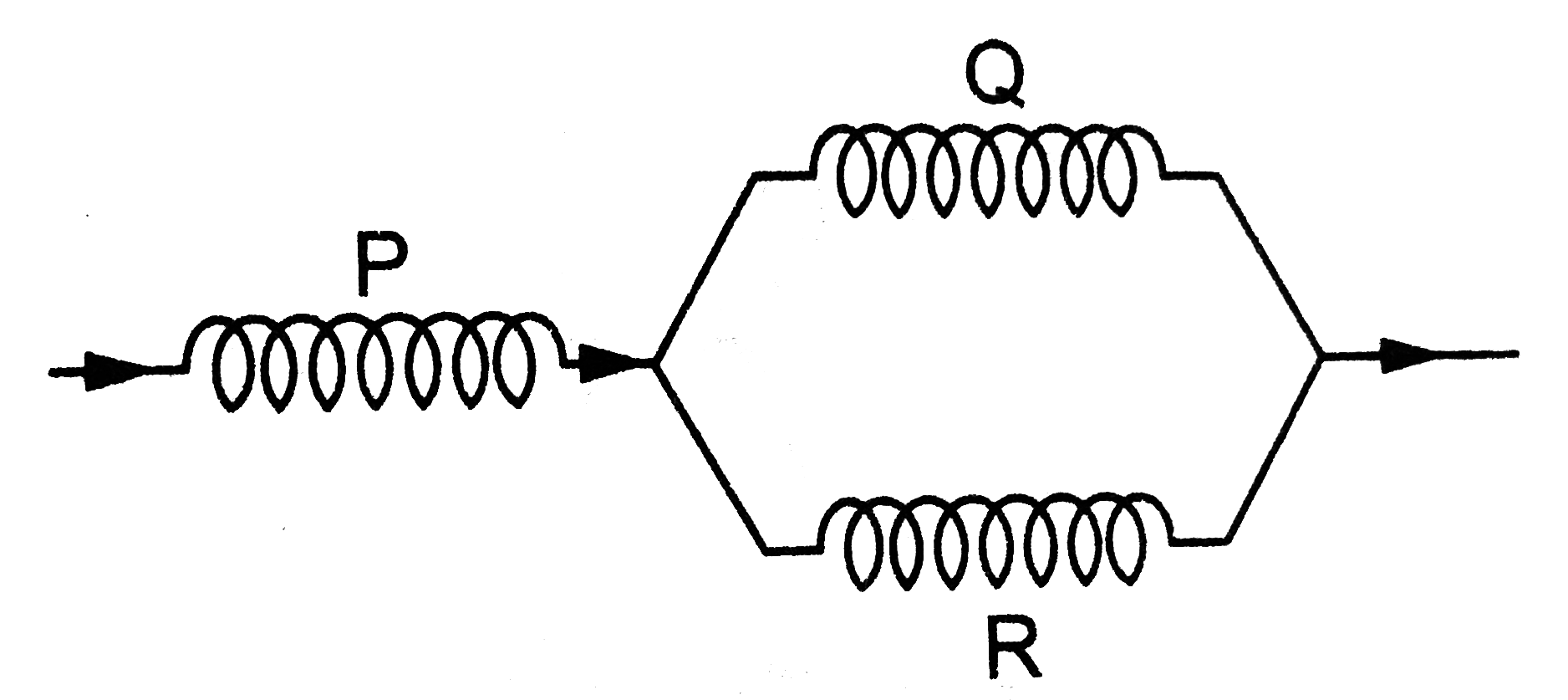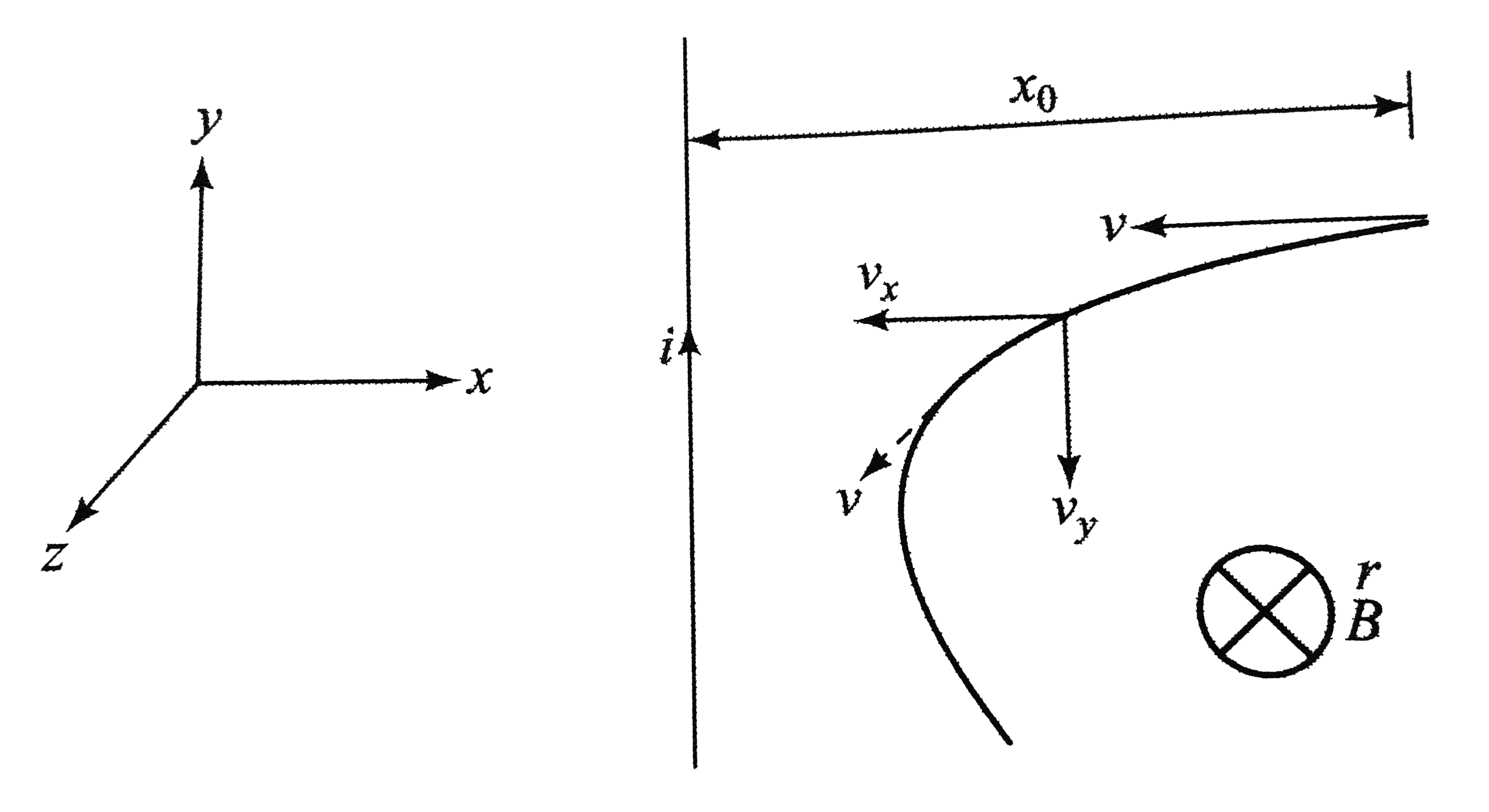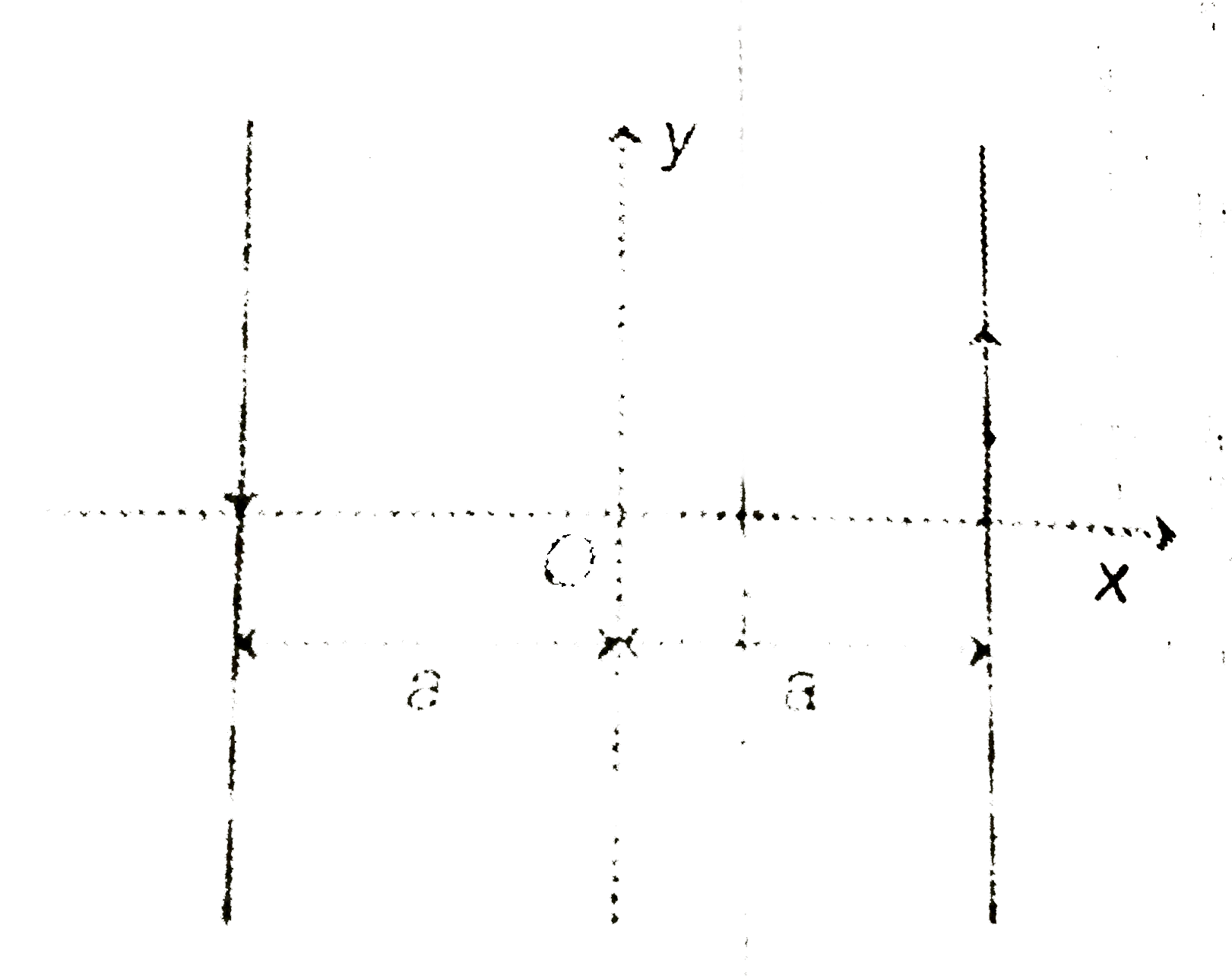A long , straight wire carries a current i. A particle having a positive charge q and mass m, kept at a distance x_0 from the wire is projected towards it with a speed v. Find the minimum separation between the wire and the particle. Solution in Gujrati
Solution: Let the particle be initially at P. Take
the wire as the y axis and the foot of perpendicular from
P to the wire as the origin. Take the line OP as the
x−aξs.Wehave,OP=x0.Themag≠ticfieldBatany<br>p∮→therightofthewireisalongthe¬ativez−aξs.<br>Themag≠ticforceonthepartic≤is,∴,∈the<br>x−ypla≠.Asthereisno∈itialvelocityalongthez−aξs,<br>themotionwillbe∈thex−ypla≠.Also,itsspeed<br>rema∈sunchan≥d.Asthemag≠ticfieldis¬<br>uniform,thepartic≤does¬goalonga∘≤.<br>Theforceattimetis( vec F)= (vec qv) xx (vec B)<br> = q((vec i)vx + (vec j)vy) xx (- (mu_0)i/2 pi x) vec k)<br> = ((vec j) q(v_x)) ((mu_0)i/2pi x) - (( vec i ) (qv_y)((mu_0)i/2 pi x)<br>Thusax=(Fxm)=−((μ0)qi2πm)(vyx)=−λ(Vyx).......(i)
whereλ=((μ0)qi2πm).
Also,ax=(dvxdt)=(dvxdx)(dxdt)=((vx)dvxdx)..........(ii)
As((vx)2)+((vy)2)=v2,
(2vx)(dvx)+((2vy)(dvy))=0
giv∈g((vx)(dvx))=−(vy)(dvy).....(iii)
From(i),(ii)and(iii),
((vy)dvydx)=λ(vy)x
or,dxx=(dvyλ).
Initiallyx=x0andvy=0.Atminiμmseparationom
thewire,vx=0sotˆvy=−v.
Thus(∫xx0)(dxx)=((∫0)−v)(dvyλ)
or,In(xx0)=(−vλ)
or, x = (x_0) (e^(-v/lambda))= (x_0) (e ^(- 2pi m v /((mu_0)qi))
Topper's Solved these Questions
- MAGNETIC FIELD DUE TO CURRENTBOOK - HC VERMACHAPTER - MAGNETIC FIELD DUE TO CURRENTEXERCISE - Short Answer
12 Videos
- MAGNETIC FIELD DUE TO CURRENTBOOK - HC VERMACHAPTER - MAGNETIC FIELD DUE TO CURRENTEXERCISE - Objective 1
12 Videos
- MAGNETIC FIELD DUE TO CURRENTBOOK - HC VERMACHAPTER - MAGNETIC FIELD DUE TO CURRENTEXERCISE - Exercises
61 Videos
- MAGNETIC FIELDBOOK - HC VERMACHAPTER - MAGNETIC FIELDEXERCISE - Exercises
61 Videos
- MAGNETIC PROPERTIES OF MATTERBOOK - HC VERMACHAPTER - MAGNETIC PROPERTIES OF MATTEREXERCISE - Exercises
9 Videos
Similar Questions
An electric current flows in a wire from north to south.
What will be the direction of the magnetic field due to this wire at a point.
View SolutionA vertical wire carries a current in upward direction. An electron beam sent horizontally towards the wire will be deflected
View SolutionUsing the formulae ((→F)=(→qv)×(→B)and(B=(μ0)i2πr), show that the SI units of the magnetic field B and the permeability constant (μ0) may be written as (NmA−1) and (NA−2) respectively.
View SolutionAn alpha particle is projected vertically upward a speed of 3.0X104kms−1 in a region where a magnetic field of magnitude 1.0 T exists in the direction south to north. Find the magnetic force that acts on the a particle.
View SolutionThe magnetic intensity H at the centre of a long solenoid carrying a current of 2.0A, is found to be 1500Am−1. Find the number of turns per centimetre of the solenoid.
View SolutionA long , straight wire carries a current i. A particle having a positive charge q and mass m, kept at a distance x_0 from the wire is projected towards it with a speed v. Find the minimum separation between the wire and the particle.

View SolutionA long straight wire carries a current i. A particle having a positive charge q and mass m, kept at distance x0 from the wire is projected towards it with speed v. Find the closest distance of approach of charged particle to the wire.


View SolutionAn infinitely long current carrying wire carries current i. A charge of mass m and charge q is projected with speed v parallel to the direction of current at a diatance r from it. Then, the radius of curvature at the point of projection is
View SolutionA long straight wire carries a current I0=100amp , a particle having a positive charge q=100C and mass m=10gms is kept at a distance x0=10m from the axis of the wire is projected away from it with a speed v0=10m/sec. Find the maximum separation between particle and wire is found to be y×10m Find y.
View SolutionA long straight wire carries a charge with linear density lamda . A particle of mass m and a charge q is released at a distance r from the the wire. The speed of the particle as it crosses a point distance 2r is
View SolutionTwo infinite long straight current carrying wires are placed parallel to y-axis in x-y plane. Each wire carries current I in opposite direction as shown. A charged particle of charge +q and mass m is projected from position P (0,0,a) with initial velocity vecv=vechatj . Then
View SolutionTwo infinitely long straight current carrying wires are placed parallel to y-axis in xy plane. Each wire carries current I in opposite directions as shown. A charged particle of charge +q and mass m is project from position P(0,0,0a) with initial velocity v=i. Then

View SolutionA positive point charge q of mass m , kept at a distance x_(0) (in the same plane) from a fixed very long straight current is projected normally away from it with speed v .Find the maximum separation between the wire and the particle.
View SolutionA long straight wire carries a current i. A particle having a positive charge q and mass m, kept at a distance x0 from the wire is projected towards it with a speed v, as shown in Fig. Find the minimum separation between the wire and the particle.
View SolutionTwo long straight wires, each carrying a current I in opposite directions are separated by a distance R. The magnetic induction at a point mid way between the wire is
View SolutionTwo infinitely long straight current carrying wires are placed parallel to y-axis in xy plane. Each wire carries current I in opposite directions as shown. A charged particle of charge +q and mass m is project from position P(0,0,0a) with initial velocity v=i. Then

View Solution
